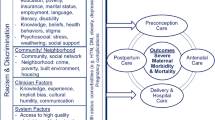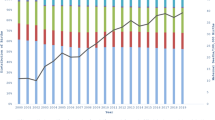Abstract
The objective of the study is to identify racial disparities in prenatal care (PNC) utilization and to examine the relationship between PNC and preterm birth (PTB), low birth weight (LBW) and infant mortality in Mississippi. Retrospective cohort from 1996 to 2003 linked Mississippi birth and infant death files was used. Analysis was limited to live-born singleton infants born to non-Hispanic white and black women (n = 292,776). PNC was classified by Kotelchuck’s Adequacy of Prenatal Care Utilization Index. Factors associated with PTB, LBW and infant death were identified using multiple logistic regression after controlling for maternal age, education, marital status, place of residence, tobacco use and medical risk. About one in five Mississippi women had less than adequate PNC, and racial disparities in PNC utilization were observed. Black women delayed PNC, received too few visits, and were more likely to have either “inadequate PNC” (P < 0.0001) or “no care” (P < 0.0001) compared to white women. Furthermore, among women with medical conditions, black women were twice as likely to receive inadequate PNC compared to white women. Regardless of race, “no care” and “inadequate PNC” were strong risk factors for PTB, LBW and infant death. We provide empirical evidence to support the existence of racial disparities in PNC utilization and infant birth outcomes in Mississippi. Further study is needed to explain racial differences in PNC utilization. However, this study suggests that public health interventions designed to improve PNC utilization among women might reduce unfavorable birth outcomes especially infant mortality.


Similar content being viewed by others
References
Alexander, G. R., & Cornely, D. A. (1987). Prenatal care utilization: its measurement and relationship to pregnancy outcome. American Journal of Preventive Medicine, 3, 243–253.
Nagey, D. A. (1989). The content of prenatal care. Obstetrics and Gynecology, 74, 516–528.
Lang, C. T., & Iams, J. D. (2009). Goals and strategies for prevention of preterm birth: an obstetric perspective. Pediatric Clinics of North America, 56, 537–563.
Alexander, G. R., & Kotelchuck, M. (2001). Assessing the role and effectiveness of prenatal care: history, challenges, and directions for future research. Public Health Reports, 116, 306–316.
Alexander, G. R., & Korenbrot, C. C. (1995). The role of prenatal care in preventing low birth weight. Future Child, 5, 103–120.
Martin J. A., Hamilton B. E., Sutton P. D., Ventura S. J., Menacker F., & Munson M. L. (2005). Births: Final data for 2003. National Vital Statistics Reports, 54.
Echevarria, S., & Frisbie, W. P. (2001). Race/ethnic-specific variation in adequacy of prenatal care utilization. Social Forces, 80, 633–655.
Rosenberg, D., Handler, A., Rankin, K. M., Zimbeck, M., & Adams, E. K. (2007). Prenatal care initiation among very low-income women in the aftermath of welfare reform: does pre-pregnancy medicaid coverage make a difference? Maternal and Child Health Journal, 11, 11–17.
Institute of Medicine. (1988). Prenatal care: Reaching mothers, reaching infants. Washington DC: National Academy Press.
Pagnini, D. L., & Reichman, N. E. (2000). Psychosocial factors and the timing of prenatal care among women in New Jersey’s Healthstart program. Family Planning Perspectives, 32, 56–64.
Maupin, R., Lyman, R., Fatsis, J., Prystowski, E., Nguyen, A., Wright, C., et al. (2004). Characteristics of women who deliver with no prenatal care. The Journal of Maternal-Fetal and Neonatal Medicine, 16, 45–50.
Taylor, C. R., Alexander, G. R., & Hepworth, J. T. (2005). Clustering of U.S women receiving no prenatal care: differences in pregnancy outcomes and implications for targeting interventions. Maternal and Child Health Journal, 9, 125–133.
Wiltshire, J. C., Person, S. D., Kiefe, C. I., & Allison, J. J. (2009). Disentangling the influence of socioeconomic status on differences between AA and white women in unmet medical needs. American Journal of Public Health, 99, 1659–1665.
Frisbie, W. P., Echevarria, S., & Hummer, R. A. (2001). Prenatal care utilization among non-Hispanic whites, African Americans, and Mexican Americans. Maternal and Child Health Journal, 5, 21–33.
Alexander, G. R., Kogan, M. D., & Nabukera, S. (2002). Racial differences in prenatal care use in the United States: are disparities decreasing? American Journal of Public Health, 92, 1970–1975.
Sarnoff, R., & Adams, E. (2001). Racial and ethnic disparities in the discordance between women’s assessment of the timing of their prenatal care entry and the first trimester standard. Maternal and Child Health Journal, 5, 179–187.
Herbst, M. A., Mercer, B. M., Beazley, D., Meyer, N., & Carr, T. (2003). Relationship of prenatal care and perinatal morbidity in LBW infants. American Journal of Obstetrics and Gynecology, 189(4), 930–933.
Collins, J. W., David, R. J., Prachand, N. G., & Pierce, M. L. (2003). Low birth weight across generations. Maternal and Child Health Journal, 7, 229–237.
Stein, J. A., Lu, M. C., & Gelberg, L. (2000). Severity of homelessness and adverse birth outcomes. Health Psychology, 19, 524–534.
Chen, X., Wen, S. W., Yang, Q., & Walker, M. C. (2007). Adequacy of prenatal care and neonatal mortality in infants born to mothers with and without antenatal high-risk conditions. Australian and New Zealand Journal of Obstetrics and Gynaecology, 47, 122–127.
Vintzileos, A. M., Ananth, C. V., Smulian, J. C., Scorza, W. E., & Knuppel, R. A. (2002). The impact of prenatal care in the United States on preterm births in the presence and absence of antenatal high-risk conditions. American Journal of Obstetrics and Gynecology, 187, 1254–1257.
Vintzileos, A. M., Ananth, C. V., Smulian, J. C., Scorza, W. E., & Knuppel, R. A. (2002). The impact of prenatal care on postneonatal deaths in the presence and absence of antenatal high-risk conditions. American Journal of Obstetrics and Gynecology, 187, 1258–1262.
Heaman, M. I., Sprague, A. E., & Stewart, P. J. (2001). Reducing the preterm birth rate: A population health strategy. Journal of Obstetric, Gynecologic, and Neonatal Nursing, 30, 20–29.
Ricketts, S. A., Murray, E. K., & Schwalberg, R. (2005). Reducing low birthweight by resolving risks: results from Colorado’s prenatal plus program. American Journal of Public Health, 95, 1952–1957.
Hoyert, D. L., Heron, M. P., Murphy, S. L., & Kung, H.-C. (2006). Deaths: final data for 2003. National Vital Statistics Reports, 54(13), 1–120.
Kaiser Family Foundation. Mississippi Poverty Rate by Race/Ethnicity (2007–2008). Downloaded on 10/10/2009 from http://www.statehealthfacts.org.
United States Census Bureau. State and County QuickFacts. (2008) Estimates revised 9/4/2009. Downloaded on 10/10/2009 from http://quickfacts.census.gov/qfd/states/28000.html.
Kotelchuck, M. (1994). An evaluation of the Kessner adequacy of prenatal care index and a proposed adequacy of prenatal care utilization index. American Journal of Public Health, 84, 1414–1420.
The American College of Obstetricians and Gynecologists. (1989). Standards for Obstetric-Gynecologic Services (7th ed.). Washington, DC.
Qin, C., Dietz, P. M., England, L. J., Martin, J. A., & Callaghan, W. M. (2007). Effects of different data-editing methods on trends in race-specific preterm delivery rates, United States, 1990–2002. Paediatric and Perinatal Epidemiology, 21, 41–49.
Qin, C., Hsia, J., & Berg, C. J. (2008). Variation between last-menstrual-period and clinical estimates of gestational age in vital records. American Journal of Epidemiology, 167, 646–652.
Laditka, S. B., Laditka, J. N., Mastanduno, M. P., Lauria, M. R., & Foster, T. C. (2005). Potentially avoidable maternity complications: An indicator of access to prenatal and primary care during pregnancy. Women and Health, 41, 1–26.
Liu, Y., Liu, J., Ye, R., & Li, Z. (2006). Association of preconceptional health care utilization and early initiation of prenatal care. Journal of Perinatology, 26, 409–413.
Grosse, S. D., Sotnikov, S. V., Leatherman, S., & Curtis, M. (2006). The business case for preconception care: Methods and issues. Maternal and Child Health Journal, 10, S93–S99.
Wise, P. H. (2008). Transforming preconception, prenatal, and interconceptional care into a comprehensive commitment to women’s health. Womens Health Issues, 18, S13–S18.
Biermann, J., Dunlop, A. L., Brady, C., Dubin, C., & Brann, A., Jr. (2006). Promising practices in preconception care for women at risk for poor health and pregnancy outcomes. Maternal and Child Health Journal, 10, S21–S28.
Atrash, H. K., Johnson, K., Adams, M. M., Cordero, J. F., & Howse, J. (2006). Preconception care for improving perinatal outcomes: The time to act. Maternal and Child Health Journal, 10, S3–S11.
Posner, S. F., Johnson, K., Parker, C., Atrash, H., & Biermann, J. (2006). The national summit on preconception care: a summary of concepts and recommendations. Maternal and Child Health Journal, 10, S197–S205.
Langston, L., Graham, J., & Zhang, L. (2009). Identifying strategies for reducing Mississippi infant mortality utilizing an analysis of trends and racial disparities. Journal of the Mississippi State Medical Association, L(3), 71–78.
National Governors Association Center for Best Practices. (2006). Maternal and child health update 2005: States make modest expansions to health care coverage. Washington DC: National Governors Association.
Health Resources and Services Administration. Find Shortage Areas: MUA/P by State and County. Downloaded on 10/10/2009 from http://www.muafind.hrsa.gov/index.aspx.
DeFranco, E. A., Lian, M., Muglia, L. A., & Schootman, M. (2008). Area-level poverty and preterm birth risk: A population-based multilevel analysis. BMC Public Health, 8, 316.
Reagan, P. B., & Salsberry, P. J. (2005). Race and ethnic differences in determinants of preterm birth in the USA: Broadening the social context. Social Science and Medicine, 60, 2217–2228.
Attar, M. A., Hanrahan, K., Lang, S. W., Gates, M. R., & Bratton, S. L. (2006). Pregnant mother out of the perinatal regionalization’s reach. Journal of Perinatology, 26, 210–214.
Health Services Data Unit. (2006). 2003 Mississippi PRAMS report. Mississippi Department of Health.
Koroukian, S. M., & Rimm, A. A. (2002). The “adequacy of prenatal care utilization” (APNCU) index to study low birth weight: is the index biased? Journal of Clinical Epidemiology, 55, 296–305.
Frick, K. D., & Lantz, P. M. (1996). Selection bias in prenatal care utilization: An interdisciplinary framework and review of the literature. Medical Care Research and Review, 53, 371–396.
Dietz, P. M., Adams, M. M., Kendrick, J. S., & Mathis, M. P. (1998). Completeness of ascertainment of prenatal smoking using birth certificates and confidential questionnaires. American Journal of Epidemiology, 148, 1048–1054.
Buescher, P. A., Taylor, K. P., Davis, M. H., & Bowling, J. M. (1993). The quality of the new birth certificate data: A validation study in North Carolina. American Journal of Public Health, 83, 1163–1165.
Reichman, N., & Hade, E. (2001). Validation of birth certificate data: A study of women in New Jersey’s HealthStart program. Annals of Epidemiology, 11, 186–193.
Acknowledgments
We gratefully acknowledge Dick Johnson for data linkage support and Daniel R. Bender for his guidance and support on this study.
Author information
Authors and Affiliations
Corresponding author
Additional information
Reagan G. Cox and Lei Zhang are co-lead authors.
Rights and permissions
About this article
Cite this article
Cox, R.G., Zhang, L., Zotti, M.E. et al. Prenatal Care Utilization in Mississippi: Racial Disparities and Implications for Unfavorable Birth Outcomes. Matern Child Health J 15, 931–942 (2011). https://doi.org/10.1007/s10995-009-0542-6
Published:
Issue Date:
DOI: https://doi.org/10.1007/s10995-009-0542-6




